Text symbolizer¶
The text symbolizer styles labels of vector features. Labels can consist of text strings and/or graphics.
Syntax¶
The full syntax of a text symbolizer is:
symbolizers:
- text:
fill-color: <color>
fill-opacity: <expression>
fill-graphic:
<graphic_options>
stroke-graphic:
<graphic_options>
stroke-graphic-fill:
<graphic_options>
label: <expression>
font-family: <expression>
font-size: <expression>
font-style: <expression>
font-weight: <expression>
placement: <point|line>
offset: <expression>
anchor: <tuple>
displacement: <tuple>
rotation: <expression>
halo:
radius: <expression>
fill-color: <color>
fill-opacity: <expression>
fill-graphic:
<graphic_options>
graphic:
symbols:
<graphic_options>
size: <expression>
opacity: <expression>
rotation: <expression>
geometry: <expression>
uom: <text>
x-composite-base: <boolean>
x-composite: <text>
x-allowOverruns: <boolean>
x-autoWrap: <expression>
x-conflictResolution: <boolean>
x-followLine: <boolean>
x-forceLeftToRight: <boolean>
x-goodnessOfFit: <expression>
x-graphic-margin: <expression>
x-graphic-resize: <none|proportional|stretch>
x-group: <boolean>
x-labelAllGroup: <boolean>
x-labelPriority: <expression>
x-repeat: <expression>
x-maxAngleDelta: <expression>
x-maxDisplacement: <expression>
x-minGroupDistance: <expression>
x-partials: <boolean>
x-polygonAlign: <boolean>
x-spaceAround: <expression>
where:
| Property | Required? | Description | Default value |
|---|---|---|---|
fill-color |
No | Color of inside of the label. | '#808080' (gray) |
fill-opacity |
No | Opacity of fill of the label text. Valid values are a decimal value between 0 (completely transparent) and 1 (completely opaque). |
1 |
fill-graphic |
No | A design to be used for the fill of the text label. Can either be a mark consisting of a common shape or a URL that points to a graphic. The <graphic_options> should consist of a mapping containing symbols: followed by an external: or mark:, with appropriate parameters as detailed in the Point symbolizer section. |
None |
stroke-graphic |
No | A design or pattern to be used along the stroke around the label text. the output will always be a linear repeating pattern, and as such is not tied to the value of stroke-width. Can either be a mark consisting of a common shape or a URL that points to a graphic. The <graphic_options> should consist of a mapping containing symbols: followed by an external: or mark:, with appropriate parameters. Cannot be used with stroke-graphic-fill. |
N/A |
stroke-graphic-fill |
No | A design or pattern to be used for the fill of the stroke around the label text. This area that is to be filled is tied directly to the value of stroke-width. Can either be a mark consisting of a common shape or a URL that points to a graphic. The <graphic_options> should consist of a mapping containing symbols: followed by an external: or mark:, with appropriate parameters as detailed in the Point symbolizer section. Cannot be used with stroke-graphic. |
N/A |
| Property | Required? | Description | Default value |
|---|---|---|---|
label |
Yes | Text to display. Often taken from an attribute but any valid expression that constructs a string will do. | N/A |
font-family |
No | Type of font to be used for the label. Options are system dependent; the full list of fonts available can be found via the GeoServer Server Status page. | serif |
font-size |
No | Size of the font. | 10 |
font-style |
No | Style of the font. Options are normal, italic, and oblique. |
normal |
font-weight |
No | Weight of the font. Options are normal and bold. |
normal |
placement |
No | Determines whether the label is to be drawn derived from a point or a line. |
point |
offset |
No | Value (in pixels) for moving the drawn label relative to the location of the feature. A positive value will shift the label in the direction of its top, while a negative value will shift the label in the direction of its bottom. Only valid for when type is set to line. |
0 |
anchor |
No | Specify the center of the symbol relative to the feature location (centroid for lines and polygons). Value is an [x,y] tuple with decimal values from 0-1, with [0,0] meaning that the symbol is anchored to the bottom left of the label, and [1,1] meaning anchored to the top right of the label. |
[0,0] |
displacement |
No | Specifies a distance (in pixels) to which to move the label relative to the feature. Value is an [x,y] tuple with values expressed in pixels, so [10,5] will displace the label 10 pixels to the right and 5 pixels up. Only valid for when type is set to point. |
[0,0] |
rotation |
No | Value (in degrees) or rotation of the label. Larger values increase counter-clockwise rotation. A value of 180 will make the label upside-down. Only valid for when type is set to point. |
0 |
halo |
No | Creates a shaded area around the label for easier legibility | No halo |
radius |
No | Size (in pixels) of the halo | 1 |
fill-color |
No | Color of the halo | '#808080' |
fill-opacity |
No | Specifies the level of transparency for the halo. Value of 0 means entirely transparent, while 1 means entirely opaque. |
1 |
The following properties allow for a graphic to be displayed in addition to just a label. This is used when drawing “shields” (text over top of a graphic) such as in road signs.
| Property | Required? | Description | Default value |
|---|---|---|---|
graphic |
No | Specifies whether a graphic is to be drawn for the label. | N/A (no graphic) |
symbols |
No | The details of the graphic. Consists of an external: or mark: section, with appropriate parameters as detailed in the Point symbolizer section. |
N/A |
size |
No | Size of the graphic in pixels. If the aspect ratio is not 1:1 (square), will apply to the height of the graphic only, with the width scaled proportionally. | 16 |
opacity |
No | Specifies the level of transparency for the graphic. Value of 0 means entirely transparent, while 1 means entirely opaque. |
1 |
rotation |
No | Value (in degrees) or rotation of the graphic. Larger values increase counter-clockwise rotation. A value of 180 will make the graphic upside-down. |
0 |
| Property | Required? | Description | Default value |
|---|---|---|---|
geometry |
No | Specifies which attribute to use as the geometry. | First geometry attribute found (usually named geom or the_geom) |
uom |
No | Unit of measure used for width calculations | pixel |
The following properties are equivalent to SLD “vendor options”.
| Property | Required? | Description | Default value |
|---|---|---|---|
x-allowOverruns |
No | Allows labels on lines to move slightly beyond the beginning or end of the line. | true |
x-autoWrap |
No | The number of pixels beyond which a label will be wrapped over multiple lines. Cannot use with x-followLine. |
0 |
x-conflictResolution |
No | Enables conflict resolution, meaning no two labels will be allowed to overlap. Without conflict resolution, symbolizers can overlap with other labels. | true |
x-followLine |
No | On linear geometries, the label will follow the shape of the current line, as opposed to being drawn at a tangent. Will override | false |
x-forceLeftToRight |
No | Forces labels to a readable orientation, otherwise will follow the line orientation, possibly making the label look upside-down. This setting is useful when using symbol fonts to add direction markers along a line. | false |
x-goodnessOfFit |
No | Percentage (expressed as a decimal between 0-1) of the label that must fit inside the geometry to permit the label to be drawn. Works only on polygon features. | 0.5 |
x-graphic-margin |
No | Number of pixels between the stretched graphic and the text. Only applies when x-graphic-resize is set to stretch or proportional. |
0 |
x-graphic-resize |
No | Allows for stretching the graphic underneath a label to fit the label size. Options are none, stretch or proportional. Used in conjunction with x-graphic-margin.. |
none |
x-group |
No | Geometries with identical labels will be considered a single entity to be labeled. Used to control repeated labels. | false |
x-labelAllGroup |
No | Used in conjunction with x-group. When true all items in a group are labeled. When false, only the largest geometry in the group is labeled. Valid for lines only. |
false |
x-labelPriority |
No | The priority used when choosing which labels to display during conflict resolution. Higher priority values take precedence over lower priority values. | 1000 |
x-repeat |
No | Desired distance (in pixels) between labels drawn on a group. If zero, only one label will be drawn. Used in conjunction with x-group. Valid for lines only. |
0 |
x-maxAngleDelta |
No | Maximum allowed angle (in degrees) between two characters in a curved label. Used in conjunction with x-followLine. Values higher than 30 may cause loss of legibility of the label. |
22.5 |
x-maxDisplacement |
No | Distance (in pixels) a label can be displaced from its natural position in an attempt to eliminate conflict with other labels. | 0 |
x-minGroupDistance |
No | Minimum distance (in pixels) between two labels in the same label group. Used in conjunction with displacement or repeat to avoid having two labels too close to each other |
No minimum distance |
x-partials |
No | Will display partial labels (truncated on the border of the display area). | false |
x-polygonAlign |
No | Overrides manual rotation to align label rotation automatically. Valid for polygons only. | false |
x-spaceAround |
No | Minimum distance (in pixels) between two labels. A negative value specifies the maximum overlap between two labels. | 0 |
| Property | Required? | Description | Default value |
|---|---|---|---|
x-composite |
No | Allows for both alpha compositing and color blending options between symbolizers. | N/A |
x-composite-base |
No | Allows the rendering engine to use the symbolizer mapping to define a “base” buffer for subsequent compositing and blending using x-composite. See the section on Feature Styles for more details. |
false |
Examples¶
Basic label¶
Text symbolizers are used to draw labels on objects. The label text is usually linked to some attribute of the layer. Font options are available in the font-family, font-size, font-style, and font-weight properties. The following example draws a label using the name attribute of the layer, and with a SansSerif font of size 12, gray color, bold and italic:
feature-styles:
- name: name
rules:
- title: fill-graphic
symbolizers:
- text:
label: ${name}
fill-color: '#555555'
font-family: SansSerif
font-size: 12
font-style: italic
font-weight: bold
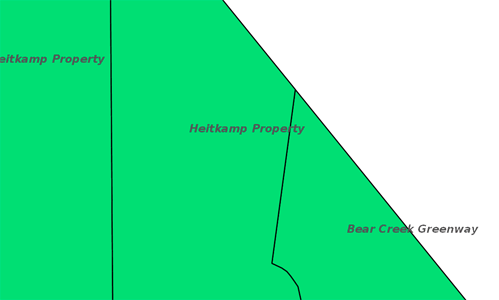
Basic label
Label with wrap¶
Wrapping long labels can improve how well they fit on maps. This can be accomplished using the x-autoWrap property. This example wraps lines longer than 70 pixels:
feature-styles:
- name: name
rules:
- symbolizers:
- polygon:
stroke-width: 1
fill-color: '#00DD77'
- text:
label: ${name}
font-size: 12
x-autoWrap: 70
x-maxDisplacement: 100
anchor: [0.5,-1]
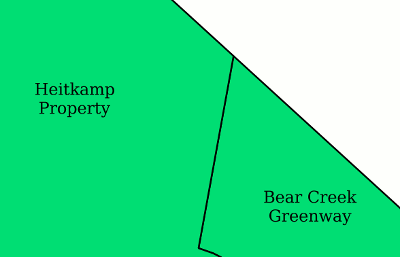
Label with wrap
Label with halo¶
Surrounding labels with a halo will allow them to be visible even on complex maps with various background features. This can be accomplished using the halo family of properties. This example surrounds the label in a partially transparent white halo of radius 2:
feature-styles:
- name: name
rules:
- symbolizers:
- polygon:
stroke-width: 1
fill-color: '#00DD77'
- text:
label: ${name}
font-size: 12
x-autoWrap: 70
x-maxDisplacement: 100
halo:
radius: 2
fill-color: '#FFFFFF'
fill-opacity: 0.8
anchor: [0.5,-1]
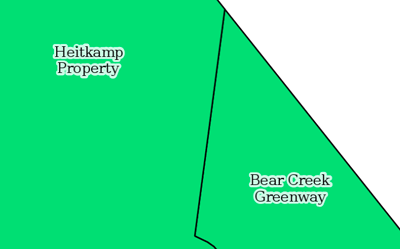
Label with halo
Grouped labels¶
Grouping and other properties can be used to better control where labels are placed. The x-group option combines all labels with identical text into a single label. This can be useful to show only a single label for a street rather than having a label on every block of the street. The x-goodnesOfFit option determines whether or not to draw labels based on how well they fit into the available space. The x-maxDisplacement option determines the maximum distance a label can be moved to avoid overlaps.
The following example uses x-group to ensure only one label is drawn for each feature, and sets x-goodnesOfFit to zero so that labels will be drawn even if they have a poor fit:
feature-styles:
- name: name
rules:
- title: fill-graphic
symbolizers:
- text:
label: ${name}
fill-color: '#555555'
font-family: SansSerif
font-size: 12
font-style: italic
font-weight: bold
x-group: true
x-goodnessOfFit: 0.0
x-maxDisplacement: 400
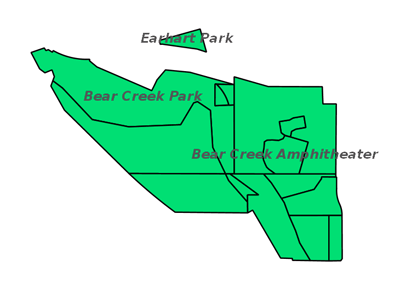
Grouped labels
Labels following lines¶
In order to have a label follow a line (and not be drawn tangent to a line), the x-followLine option can be set. Other properties can be used in conjunction with this to achieve the best visual result. The following example has street names following the line of the street, with a maximum angle of 90 degrees, repeating every 150 pixels:
feature-styles:
- rules:
- symbolizers:
- line:
stroke-color: '#EDEDFF'
stroke-width: 10
- text:
label: name
x-followLine: true
x-maxAngleDelta: 90
x-maxDisplacement: 400
x-repeat: 150
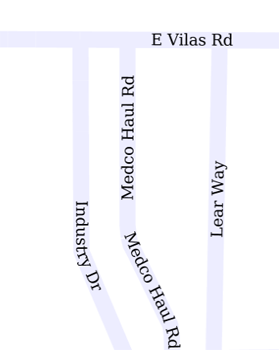
Labels following lines
Labels avoiding obstacles¶
The x-labelObstacle option is used to mark a different symbolizer as an obstacle that labels should avoid. This example draws labels and points on a line geometry, and also uses a point symbolizer to draw the vertices of the lines as points. It is those points which are set to be treated as obstacles to be avoided:
feature-styles:
- rules:
- symbolizers:
- line:
stroke-color: '#00BBDD'
stroke-width: 10
- rules:
- symbolizers:
- point:
geometry: ${vertices(the_geom)}
x-labelObstacle: true
symbols:
- mark:
shape: circle
stroke-color: '#000000'
fill-color: '#007777'
- text:
label: ${streetname}
x-maxDisplacement: 400
x-followLine: true
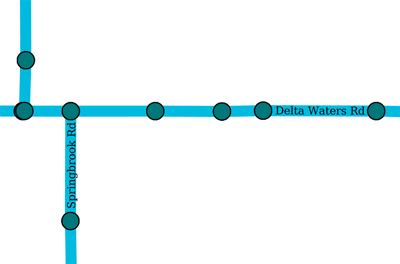
Labels avoiding obstacles
Road Shields¶
The graphic option is used to display a symbol behind a label. A common use for this is to display “highway shields” behind road numbers. This example uses a circle shape to draw state shields, and an external image to draw interstate shields, then draws road names on top. The x-graphic-resize and x-graphic-margin options are used to resize the graphics to fit the label text:
feature-styles:
- name: state
rules:
- filter: ${level ilike 'State'}
symbolizers:
- line:
stroke-color: '#AAEE00'
stroke-width: 4
stroke-linecap: round
- text:
label: ${name}
anchor: [0.5, 0.5]
fill-color: black
font-family: SansSerif
font-weight: bold
font-size: 8
x-graphic-resize: stretch
x-graphic-margin: 6
graphic:
symbols:
- mark:
shape: circle
fill-color: white
stroke-color: black
- name: interstate
rules:
- filter: ${level ilike 'Interstate'}
symbolizers:
- line:
stroke-color: '#99CC00'
stroke-width: 6
stroke-linecap: round
- text:
label: ${name}
anchor: [0.5, 0.5]
fill-color: white
font-family: SansSerif
font-weight: bold
font-size: 8
x-graphic-resize: stretch
x-graphic-margin: 6
graphic:
symbols:
- external:
url: interstate.png
format: image/png
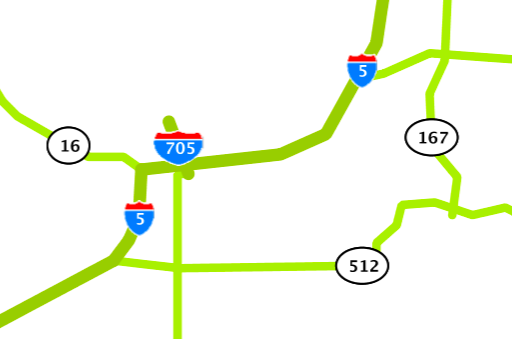
Road Shields